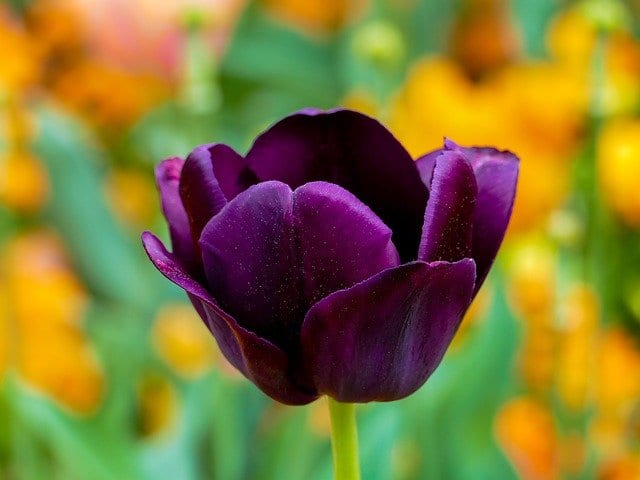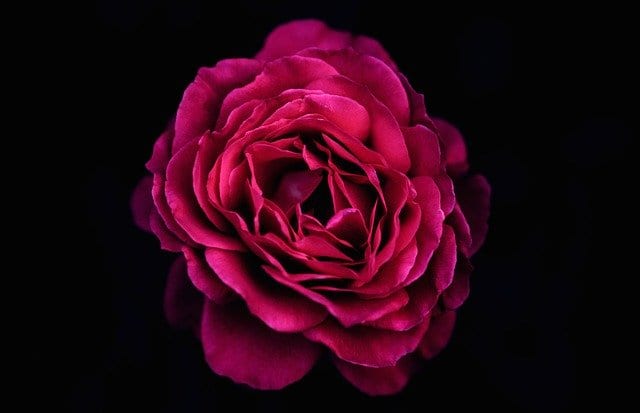
Back in the old days, in the Edwardian and Victorian eras, black gardens were all the rage. These were gardens that were highly coveted by gardeners. A garden like this had dark-colored flowers. It symbolized an air of mystery and often appeared dramatic with its almost-. black flowers
One thing to note is that “black flowers” are not really black. They are dark flowers, usually very deep dark purple or red. Specific aspects of your garden will determine how dark your flowers will look. The pH of the soil can influence the darkness of your flowers. Darker plants need more water as they absorb sunlight and are prone to withering quicker. You can create a lovely black garden by choosing flowers of different textures and heights to make your garden look stunning.
The following black flowers are some that you can select for a unique array of nature in your home or garden.
Tulip
The ‘Queen of the Night’ tulip is a dark burgundy tulip variety that comes closest to a black flower. In the spring, it is a deep maroon color. Tulips don’t need much tending to, so they are great flowers for a novice gardener. Tulips are also a very hardy flowers, and grow abundantly, blooming in spring and very early summer. Their darkness is breathtaking and contrasts well with white or pink tulips.
Before The Storm Iris
Botanists have truly done wonders by creating several hybrid variations of the iris flower to suit every mood and desire. In the midst of these endless hybrids, is the bearded variety of the iris flower. The Before The Storm iris is one such plant. It is a tall flower among black flowers. This awe-inspiring purple-black bloom has a compelling fragrance and attracts butterflies, bees and birds. As a result, it aids in the pollination process. It begins to bloom in late spring or early summer. It needs sunlight to grow and develop into a tough plant. Irises are drought-resistant black flowers that require soil that is drained well. The iris is a very easy dark flower to grow and looks elegant and stately.
Arabian
This kind of dark dahlia flower is subtle yet holds its own in a garden of black flowers. The flower has a deep purple to red color. This gives the illusion of black when the flower is in the shade. The plant needs shade only in extreme hot weather in summer. Blooms are large with rounded petals that form in thick clusters. Petals have spikes. When cut and placed in a vase inside your home, they will live for quite a while in just water. They tend to look healthy if you care fir them properly, changing the water on a daily basis. These flowers don’t do well in cold climates. Ideal ground temperature for planting must be at least around 60 degrees Fahrenheit (15.56 degree Celsius). Well drained, yet moist soil with sunlight are the typical growing requirements for this iris flower.
Black Velvet Petunia
Horticulturists created this flower in 2010. It developed as a hybrid version of the original purple petunia. At a glance, it appears blacker than any other dark flower. When you go up close, you will notice just a tiny sign of purple in the flower. These flowers grow very quickly, and can form a crowd in your garden before you know it. Flower petals look and feel like velvet cloth. Black petunias don‘t thrive in the frost, but are quite robust otherwise. Harsh winds and watering them too much will make the plants wilt. They need soil that is properly drained.
Black Rose
Truth be told, these roses only look black due to the fact of their dark deep burgundy hue. Their petals have a luxuriant velvety feel. These roses need soil that is sandy or filled with mulch. They don’t do well in clay-based soil. These black flowers need shade, but only partial shade, to grow and develop in a healthy way. Soil must be packed and arranged very slackly after planting the seeds. Take care to see that the soil is semi-moist. Too much moisture will cause mold and this will hamper growth of the black rose.

In hot weather, Black roses need watering only approximately three times a week. Organic fertilizer will help black roses grow better. The blooms need this at the beginning of the growing season and towards the middle of it. In January and February, the plants need pruning all the way down so that only four to six inches of stem show. Fungus attacks black rose petals very easily and you may have to treat your blooms with a requisite pesticide. A variety of these are Black Baccara Roses that you may consider growing.
Black Magic Hollyhock
Black Magic Hollyhocks are tall, towering plants that are an attractive blue-black shade. Flowers are in the shape of bowls which will loom over the rest of the blooms in your garden. They have leafy stalks that can grow to a maximum height of 10 feet. The Alcea Rosea or Black Magic Hollyhock is best suited to growing against a wall. It will also thrive as a border at the edge of your garden. It acts as a virtual protective lanky wall itself. Flowers have tinges of red and purple sometimes, giving these a rich look. In late fall, the last of these flowers seed, so the tall stems need to be cut down. They need fully drained soil and a lot of sunshine.
Black Star/Odessa Calla Lily
The Black Star Calla Lily is one of the deepest and darkest black flowers you can grow. It is exquisite when used in floral arrangements and can be grown in a container or planted in the soil. It looks nice on a patio wall in a container. This is a bloom that is a hue of the deepest purple, covered with a black sheath. The foliage is very unusual and light green with red specks. The plant grows to heights of 18 to 20 inches, and is spread over 7 to 8 inches.
Plants need a lot of sunlight to grow. Summer is the ideal season for the growth of these black flowers. They need the shade of the afternoon and do well in rich, organic compost-filled soil. Soil must be moist. After new growth, a mild pesticide may be used. Black Calla Lillies May be grown indoors in containers. If you have a pet, you need to be extra careful as these flowers are toxic to cats and dogs.
Black Bat Flower
This flower grows in limited soils and areas. Nonetheless, it has a magnetic appeal. It has a distinctive appearance and is referred to as “devil flower” and “cat’s whiskers”. The blossom looks similar to a flying bat. It needs warm tropical or sub-tropical climate conditions to grow outdoors. If you own a garden indoors or are fortunate to live in the ideal conditions that this plant requires, it will steal the show. The Black Bat Flower needs only a partial amount of shade and well-drained soil.
Silver Laced Primrose
Though this flower is not completely black, it has dark petals with a silvery white outline. It is a rare bloom and you may not come by seeds easily. When you peer at the petals up close, they are actually very dark brown. The centers of these flowers are a yellow gold hue. Fragrant blooms start to grow in spring. The plant is versatile, growing in cool or warm climes. It needs moist soil and shade partially.
Molly Sanderson Pansy
The flower is best grown in beds of gardens or in containers. It is also called the Viola flower. These blooms are quite strong, as long as you ensure they get huge amounts of water. The Viola will die in drought-like conditions. As long as the soil is kept moist, this flower will bloom in abundance. They grow well from spring right until fall. Their centers have a light shade and look ideal at borders and edges of gardens.
Odyssey Onyx Hellebore
The color of this hellebore is deep dark burgundy, appearing black to the untrained eye. It blooms in early spring and is the favorite of gardeners as it is a perennial flower. It has black leaves that are like leather to the touch. The flower petals are yellow, but to the naked eye, they look like stamen bursting from the center of the plant. Hellebores need a lot of air circulation, both above and below the soil. You will need to dig the soil just enough for air to enter. These plants need their breathing space so try not to crowd other plants too near them. Invasive ones will encroach on hellebore space and suffocate them.
Black Coneflower
This is really a wildflower which is perennial. When grown in ideal conditions of full sunlight and garden soil, the plant reaches heights of 5 feet. The plant grows in clumps and will take over your garden in a short span. It grows up to 3 or 4 feet wide in time. It has a bit of yellow on the head if the flower which is otherwise darkest brown to black.
If you don’t like the idea of a completely dark garden, it’s good to add some black flowers to accentuate contrasting colored flowers and plants.
